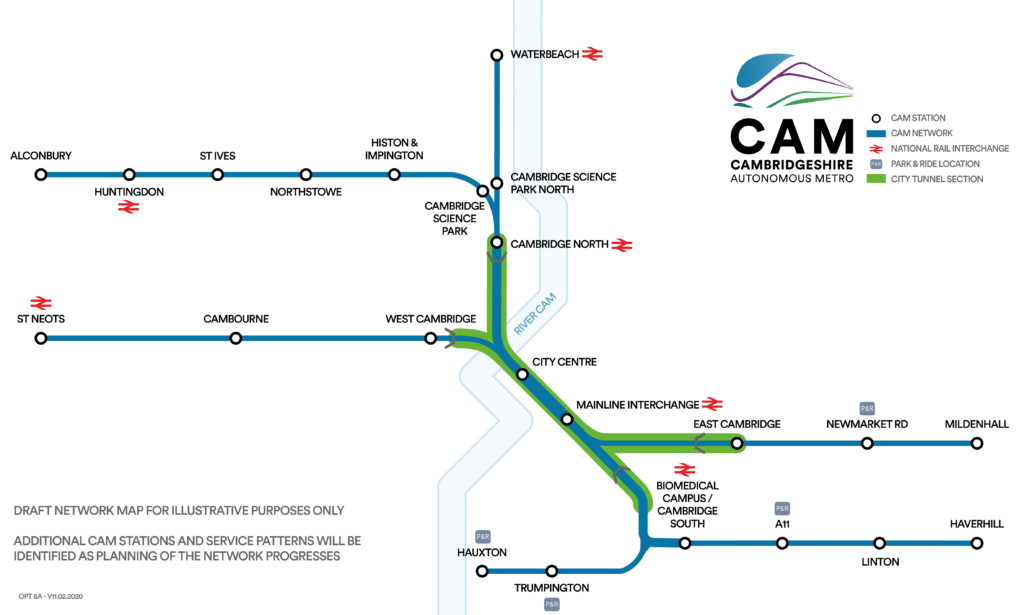The Mayor of Cambridgeshire & Peterborough on making CAM a reality by 2030
Plans for the Cambridgeshire Autonomous Metro (CAM) to provide a public transport solution with trailblazing 21st century technology continue to move forward at pace.
This month has seen innovative concept designs presented to the Cambridgeshire & Peterborough Combined Authority by suppliers Dromos Technologies, Egis and Mott MacDonald.
While it is expected that all three conceptual approaches to the zero-emission vehicles will demonstrate a preference for rubber tyres rather than wheels on rails, those driving the project are keeping an open-mind ahead of the presentations. While no final decision has been made, the current expectation for CAM is a rubber-tyred vehicle rather than a tram or light rail solution.
The three suppliers had just three months to work up their concepts following a procurement process that commenced in September 2020. The Combined Authority may draw innovative, potentially transformational ideas from the submitted concept designs for incorporation into the business case options. The next business case phase commences in April, and in 2021 the new special purpose vehicle, One CAM Ltd, will continue to be established as the lead delivery body, including through the recruitment of a CEO.
CAM has an anticipated cost of £4bn. CAM will initially extend from St Neots to Haverhill and from Alconbury to Mildenhall, via tunnels under Cambridge. The CAM system is designed to be flexible, being able to easily extend to other locations beyond the initial network plan.
Whatever materialises at the conceptual stage, CAM will aim to connect seamlessly to the rail network. In providing high quality public transport to the region, CAM will connect towns, villages, major employment sites and the city of Cambridge – linking to the East Coast Mainline, West Anglia Mainline, the Fen Line, Ipswich-Ely line, Breckland line and the planned East West Rail. CAM promises fast, frequent, and reliable journeys, seamlessly connecting with other modes of transport and linking to other new infrastructure being built such as the Cambridge South rail station.
There are also obvious benefits to reducing congestion in and around Cambridge while tackling air quality issues by reducing car use and a clear boost for the regional economy by enabling business growth, job creation and underlining Cambridgeshire’s position as a leader in biosciences, advanced engineering, agri-tech, robotics, AI and digital.
The Mayor of Cambridgeshire and Peterborough, James Palmer, placed CAM at the centre of the campaign that saw him elected in 2017. He is in no doubt that CAM will allow the East of England ceremonial county to raise its profile as a UK-leading technological and innovation hub.
James said: “We see Cambridge, Cambridgeshire and Peterborough as one of the most important 21st century economic centres for the UK. By investing in the right transport network now you set the seeds for growth. This is probably the largest public transport system outside of a major city anywhere in Europe.
“I’ve lived in the region all of my life and seen Cambridge grow from a rural city with an exceptional University to one of the great international business centres for science and technology. We’ve brought more high paid individuals into the area and the value of property has increased significantly.
“Yet despite that growth the road network and transport is the same as it was in the 1980s. There is massive congestion and housing constraints and we have a green belt issue that creates problems for further growth. Together it is an issue that’s difficult to solve.
“CAM is designed to ease the congestion and, by going under the city, will avoid environmental damage and any effect on listed buildings. As much as we’re talking about a transport network, this is a platform for sustainable growth for the Cambridgeshire economy, that takes public transport to the heart of rural Cambridgeshire and into Suffolk as well, to spread the wealth and growth across a wider area, to make it more sustainable with an environmentally-friendly model.
“Cambridgeshire has the ability to be the leading tech cluster in its field but the geography and the lack of infrastructure hampers that. We’re currently the 58th biggest tech cluster in the world and one of the most financially successful. But we want to climb higher and CAM is pivotal to our growth and global standing.”
Given the need for a public transport solution sooner rather than later, critics might wonder why a proven off-the-shelf light rail option, rather than a bespoke system, was not the first and obvious choice. Existing light rail options are not currently preferred due to the costs and expected levels of demand, the flexibility benefits of a tyred solution, and the objective of technologically futureproofing the network, including advances in autonomous operations.
Those determined to make CAM a reality by 2030 want other towns and cities to consider adopting whatever they go on to develop and to be “at the vanguard of the revolution in public transport.”
James said: “Our ambition is to sell this worldwide. The smallest cities have not had enough investment, or in some cases any investment, in public transport, to the extent desired or necessary. We have a unique opportunity to solve what is a different problem that will change the dynamic of cities like Cambridge. We are developing a bespoke system for this Metro that we can sell across the world. We will build something world-leading and not just a transport solution for similar-sized cities but something that also allows businesses to flourish and new communities to thrive.
“There are lots of cities with similar problems all over the world and this issue is vexing their minds. If we can bring forward an innovative, future-thinking transport system we’re in no doubt that this concept could be replicated in other areas.”
The ambitious nature of the project also applies to its delivery, outlined to take place over just 10 years, with tunnel sections opened and wider trunk branches constructed across several phases. Parallel tracking will see design run alongside software and systems development.
The good news for engineers is that the ground under Cambridge is conducive to tunnelling, while the addition of some big players to the CAM team ensures the project is grounded in reality and that the ambition can be matched by efficient and on-budget delivery. For example, Lord Robert Mair CBE, recognised internationally as an authority on major infrastructure projects involving tunnelling, is chair of One CAM Ltd.
As for the autonomous vehicles that will carry passengers, nothing is set in stone as yet, even how they will be powered – with electric and hydrogen under consideration. The CAM system will interact with other transport systems in Cambridgeshire, seamlessly interweaving with existing public transport.
The £4bn required to make CAM a reality will be sought from a combination of sources from the public purse and international and UK investors as part of a developing funding and financing strategy. To date the project has been funded by the Combined Authority and one of the next steps is a request for seed funding from government.
James added: “Almost uniquely we have built-in several ways to raise money locally; there’s land value capture, and the ability for tax increment financing, which the Cambridgeshire economy is well-suited for. We think we can raise a significant amount of money locally, while there’s also a tremendous opportunity here for international and UK investors. This is an eminently affordable scheme within our economy and within the concept of UK plc.
“I am a great fan of rail and we want to break down the barriers of what can be achieved when it comes to joining up different modes of transport. Right from the concept process and through into design and manufacture, we’re taking advantage of the autonomous revolution that could see the development of a new type of transport. Rail has been hugely successful for 200 years and transformed the world. Now is the time for the next revolution in transport.”








































 0113 2082620
0113 2082620 info@railbusinessdaily.com
info@railbusinessdaily.com 15 Mariner Court, Wakefield WF4 3FL
15 Mariner Court, Wakefield WF4 3FL

